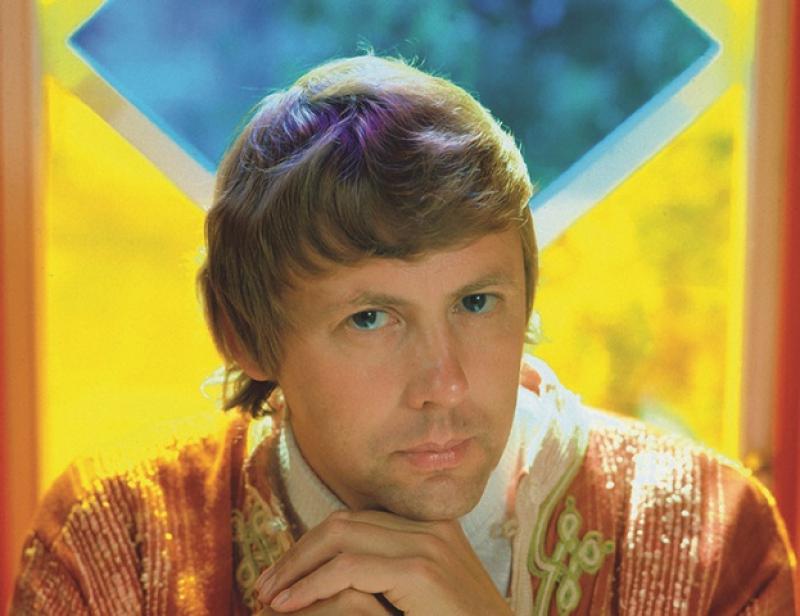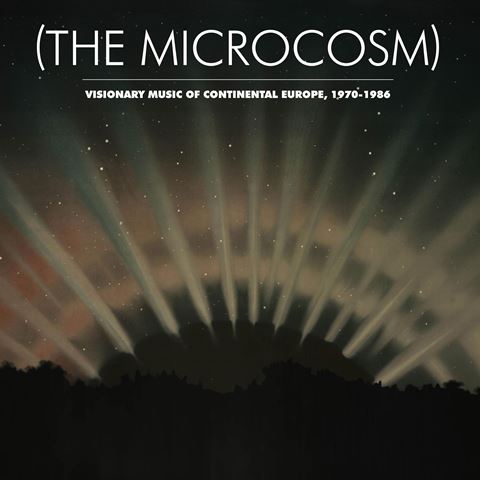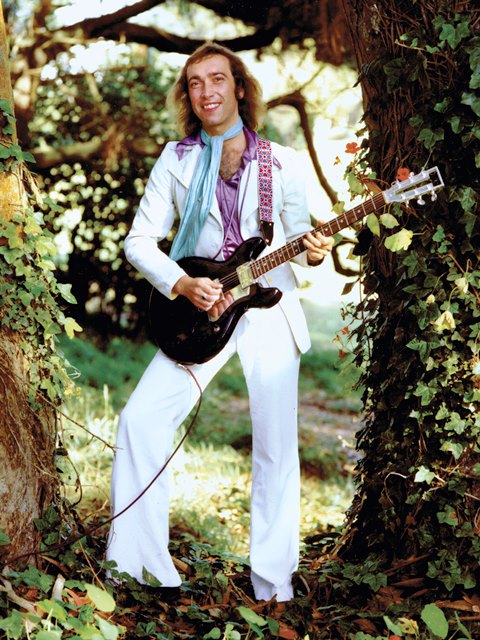Reissue CDs Weekly: The Microcosm | reviews, news & interviews
Reissue CDs Weekly: The Microcosm
Reissue CDs Weekly: The Microcosm
Astounding, ground-breaking exploration of the ‘visionary music of Continental Europe’

Pictured above is Sweden’s Ralph Lundsten. He might look like a guru or mystic but is actually a multi-disciplinary artist most well-known on his home turf for his pioneering electronic music. His first album, 1966’s Elektronmusikstudion Dokumentation 1 (made with Leo Nilson), was issued by national Swedish radio’s own label and recorded at the station’s electronic music studio.
Lundsten’s “Bön 5 – “Förlåt oss våra skulder” (Prayer 5 – Forgive us our Debts) from the 1972 album Fadervår (Our Father) features on the new 16-track compilation The Microcosm: Visionary Music of Continental Europe 1970–1986. True to the collection’s title, it's a drifting, meditative mood piece eschewing overt melody and rhythm. The synthesisers sound like distant wind chimes, flutes and the glass harmonica. Crucially, 1982 saw Lundsten release an album titled The New Age.
 The Microcosm is the follow-up to 2013’s I am the Center, the benchmark exercise in defining and tracking new age music. That, though, largely began as an American phenomenon and had a path which could be (relatively) easily delineated. The Microcosm exists in a less cut-and-dried world, circumstances made all-too clear in the booklet's introductory essay which notes “at least one artist on this collection made it known they would not take part in any project describing their music as ‘New Age’.” The text goes on to discuss musics tagged as ambient, cosmic, Neuzeit (modern time) or visionary and states “the hope here is to unify the streams.”
The Microcosm is the follow-up to 2013’s I am the Center, the benchmark exercise in defining and tracking new age music. That, though, largely began as an American phenomenon and had a path which could be (relatively) easily delineated. The Microcosm exists in a less cut-and-dried world, circumstances made all-too clear in the booklet's introductory essay which notes “at least one artist on this collection made it known they would not take part in any project describing their music as ‘New Age’.” The text goes on to discuss musics tagged as ambient, cosmic, Neuzeit (modern time) or visionary and states “the hope here is to unify the streams.”
Ash Ra Tempel, Popul Vuh, Rodelius and Vangelis are the (again, relatively) everyday names collected. The less familiar include Lundsten, Robert Julian Horky (from Austria), Ariel Kalma (France), Francesco Messina (Italy) and Enno Velthuys (The Netherlands). Germany has most representatives but this is not a compilation of what could be called Krautrock, though it could pass for one of music made in its currents or slipstream. Nothing from Britain is included and Eno is mentioned in passing. Most tracks were originally issued on vinyl, but four were cassette-only: like much new age music. Bernard Xolotl’s (pictured below left) “Cemetary Wailing (Night Plateau)” wasn’t even released as such: it is drawn from a hand-annotated, self-compiled, shop-bought TDK cassette.
 Manifestly, the painstakingly compiled The Microcosm is a labour of love. It is well annotated and made even more special by its use of wonderful artworks by the earlier but simpatico painters Aleksandra Ionowa (Finland: 1899 –1980) and Étienne Trouvelot (French-born, but America-dwelling from 1852: 1827–95).
Manifestly, the painstakingly compiled The Microcosm is a labour of love. It is well annotated and made even more special by its use of wonderful artworks by the earlier but simpatico painters Aleksandra Ionowa (Finland: 1899 –1980) and Étienne Trouvelot (French-born, but America-dwelling from 1852: 1827–95).
In seeking to define a strand of music by plucking single tracks from potentially huge back catalogues there is an ever-present danger that what’s heard is not representative of, say, Vangelis overall. It is one aspect of the particular artist. A slight disquiet with tracks perhaps being shoehorned-in to define something akin to a genre does lurk while The Microcosm unfolds. But no matter. This is an issue endemic to any multi-artist, style-specific compilation and only bubbles up as this is the first time this has been done with this particular music.
As for the music: it’s astounding. As such. All of it. The fact that this is a unified yet varied listen reflects another aspect of the care taken in the track selection. While best not to spoil the surprises, Deutsche Wertarbeit’s pulsing “Der Grosse Atem” stands out. Deutsche Wertarbeit (German Quality or German Craftsmanship) – the recording name of Dorothea Raukes – issued a single, eponymous album on the Sky label in 1981. From it, “Der Grosse Atem” grabs attention due to its immediacy and urgency. It as if the vision in Raukes’s head had suddenly manifested to unite her and her Korg 3300 synthesiser as one.
This is what The Microcosm: Visionary Music of Continental Europe 1970–1986 taps into. An unbridled need to express a sense of consciousness. Which is what the best music must be about.
Share this article
Add comment
The future of Arts Journalism
You can stop theartsdesk.com closing!
We urgently need financing to survive. Our fundraising drive has thus far raised £49,000 but we need to reach £100,000 or we will be forced to close. Please contribute here: https://gofund.me/c3f6033d
And if you can forward this information to anyone who might assist, we’d be grateful.

Subscribe to theartsdesk.com
Thank you for continuing to read our work on theartsdesk.com. For unlimited access to every article in its entirety, including our archive of more than 15,000 pieces, we're asking for £5 per month or £40 per year. We feel it's a very good deal, and hope you do too.
To take a subscription now simply click here.
And if you're looking for that extra gift for a friend or family member, why not treat them to a theartsdesk.com gift subscription?
more New music
 Heartbreak and soaring beauty on Chrissie Hynde & Pals' Duets Special
The great Pretender at her most romantic and on the form of her life
Heartbreak and soaring beauty on Chrissie Hynde & Pals' Duets Special
The great Pretender at her most romantic and on the form of her life
 The Last Dinner Party's 'From the Pyre' is as enjoyable as it is over-the-top
Musically sophisticated five-piece ramp up the excesses but remain contagiously pop
The Last Dinner Party's 'From the Pyre' is as enjoyable as it is over-the-top
Musically sophisticated five-piece ramp up the excesses but remain contagiously pop
 Moroccan Gnawa comes to Manhattan with 'Saha Gnawa'
Trance and tradition meet Afrofuturism in Manhattan
Moroccan Gnawa comes to Manhattan with 'Saha Gnawa'
Trance and tradition meet Afrofuturism in Manhattan
 Soulwax’s 'All Systems Are Lying' lays down some tasty yet gritty electro-pop
Belgian dancefloor veterans return to the fray with a dark, pop-orientated sound
Soulwax’s 'All Systems Are Lying' lays down some tasty yet gritty electro-pop
Belgian dancefloor veterans return to the fray with a dark, pop-orientated sound
 Music Reissues Weekly: Marc and the Mambas - Three Black Nights Of Little Black Bites
When Marc Almond took time out from Soft Cell
Music Reissues Weekly: Marc and the Mambas - Three Black Nights Of Little Black Bites
When Marc Almond took time out from Soft Cell
 Album: Mobb Deep - Infinite
A solid tribute to a legendary history
Album: Mobb Deep - Infinite
A solid tribute to a legendary history
 Album: Boz Scaggs - Detour
Smooth and soulful standards from an old pro
Album: Boz Scaggs - Detour
Smooth and soulful standards from an old pro
 Emily A. Sprague realises a Japanese dream on 'Cloud Time'
A set of live improvisations that drift in and out of real beauty
Emily A. Sprague realises a Japanese dream on 'Cloud Time'
A set of live improvisations that drift in and out of real beauty
 Trio Da Kali, Milton Court review - Mali masters make the ancient new
Three supreme musicians from Bamako in transcendent mood
Trio Da Kali, Milton Court review - Mali masters make the ancient new
Three supreme musicians from Bamako in transcendent mood
 Hollie Cook's 'Shy Girl' isn't heavyweight but has a summery reggae lilt
Tropical-tinted downtempo pop that's likeable if uneventful
Hollie Cook's 'Shy Girl' isn't heavyweight but has a summery reggae lilt
Tropical-tinted downtempo pop that's likeable if uneventful
 Pop Will Eat Itself's 'Delete Everything' is noisy but patchy
Despite unlovely production, the Eighties/Nineties unit retain rowdy ebullience
Pop Will Eat Itself's 'Delete Everything' is noisy but patchy
Despite unlovely production, the Eighties/Nineties unit retain rowdy ebullience

Comments
Thank you for an informed and
Yes - “Shiva’s Dance”, from
Yes - “Shiva’s Dance”, from her 1983 cassette album Transmission (made with Christian Buehner), is included.